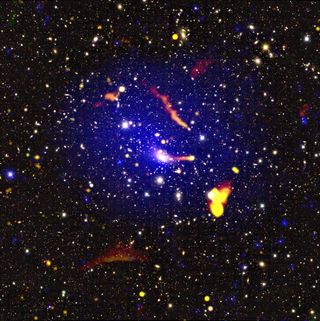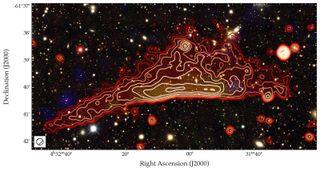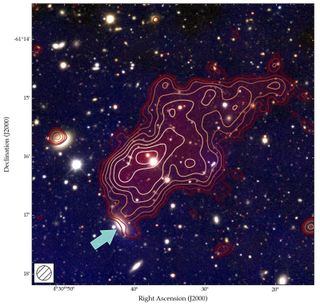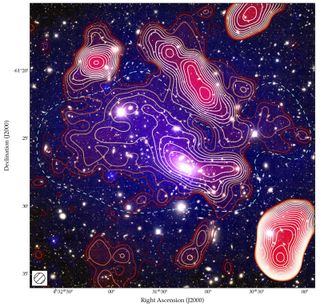This article was originally published on The conversation. (opens in a new tab) The publication contributed the article to Space.com’s Expert Voices: Editorials and Perspectives.
Christopher Riseley (opens in a new tab)researcher, University of Bologna
Tessa Vernstrom (opens in a new tab)Senior Researcher, University of Western Australia
The universe is littered with clusters of galaxies – huge structures stacked at the intersections of cosmic web (opens in a new tab). A single cluster can span millions of light-years and be made up of hundreds or even thousands of galaxies.
However, these galaxies represent only a few percent of the total mass of a cluster. About 80% of it is dark matter, and the rest is a “soup” of hot plasma: gas heated to over 10,000,000 degrees Celsius and interwoven with weak magnetic fields.
We and our international team of colleagues have identified a series of rarely observed radio objects – a radio relic, a radio halo and a fossil radio emission – within a particularly dynamic galaxy cluster called Abell 3266. They challenge existing theories on the origins of these objects and their characteristics.
Relics, aureoles and fossils
Galaxy clusters allow us to study a wide range of rich processes, including magnetism and plasma physics, in environments that we cannot recreate in our laboratories.
When the clusters collide with each other, huge amounts of energy are put into the particles of the hot plasma, generating radio emissions. And this show comes in a variety of shapes and sizes.
One example is “radio relics”. They are arc-shaped and sit on the periphery of a cluster, powered by shock waves passing through the plasma, which cause a jump in density or pressure and energize the particles. An example of a shock wave on Earth is the sonic boom that occurs when an aircraft breaks the sound barrier.
The “radio halos” are irregular sources located towards the center of the cluster. They are powered by turbulence in the hot plasma, which energizes the particles. We know that halos and relics are generated by collisions between clusters of galaxies, but many of their grainy details remain elusive.
Then there are the “fossil” radio sources. These are the radio remains of the death of a supermassive black hole at the center of a radio galaxy.
When in action, black holes fire huge jets plasma (opens in a new tab) far beyond the galaxy itself. As they run out of fuel and shut down, the jets begin to dissipate. The remains are what we detect as radiofossils.
Abel 3266
Our new paper (opens in a new tab)published in the Monthly Notices of the Royal Astronomical Society, presents a very detailed study of a cluster of galaxies called Abell 3266.
It is a particularly dynamic and disorderly collision system about 800 million light-years away. It has all the characteristics of a system that should to be host to relics and halos – but none had been detected until recently.
Follow-up of the work carried out using the Murchison Widefield Array (opens in a new tab) earlier This year (opens in a new tab)we used new data from the ASKAP radio telescope (opens in a new tab) and the Australian Telescope Compact Array (opens in a new tab) (ATCA) to see Abell 3266 in more detail.
Our data paints a complex picture. You can see it in the main image: the yellow colors indicate the elements where the energy supply is active. The blue haze represents hot plasma, captured at x-ray wavelengths.
Redder colors show features that are only visible at lower frequencies. This means that these objects are older and have less energy. Either they lost a lot of energy over time or they never had much to start with.
The radio relic is visible in red near the bottom of the image (see below for zoom). And our data here reveals special features that have never been seen before in a relic.
Its concave shape is also unusual, earning it the catchy nickname “upside down” relic. Overall, our data shatters our understanding of how relics are generated, and we are still working to decipher the complex physics behind these radio objects.
Ancient remains of a supermassive black hole
The radiofossil, seen towards the upper right corner of the main image (and also below), is very faint and red, indicating that it is ancient. We believe this radio emission originally came from the lower left galaxy, with a central black hole that has long been extinct.
Our best physical models simply cannot match the data. This reveals gaps in our understanding of the evolution of these sources, gaps that we are working to fill.
Finally, using a clever algorithm, we defocused the main image to look for a very faint, invisible high-resolution emission, unearthing the first detection of a radio halo in the Abell 3266 (see below).
To the future
This is the beginning of the path to understanding Abell 3266. We have uncovered a wealth of new and detailed information, but our study has raised even more questions.
The telescopes we’ve used have been laying the groundwork for groundbreaking science since the square kilometer network (opens in a new tab) project. Studies like ours allow astronomers to find out what we don’t know, but you can be sure we’ll find out.
We acknowledge the Gomeroi people as the traditional owners of the site where the ATCA is located, and the Wajarri Yamatji people as the traditional owners of the Murchison Radio Astronomy Observatory site, where ASKAP and the Murchison Widefield Array are located.
This article is republished from The conversation (opens in a new tab) under Creative Commons license. Read it original article (opens in a new tab).
Follow all Expert Voices issues and debates — and join the discussion — on Facebook and Twitter. The opinions expressed are those of the author and do not necessarily reflect the views of the publisher.



